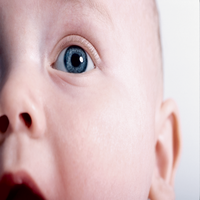Eye Color: An Instant Paternity Test?

Most of us learned some genetics in high school. You were probably taught about sweet peas, height and eye color. If mom and dad have blue eyes and little Johnny has brown, then mom probably has some explaining to do.
Sweet peas, height and eye color are examples of genetic determinism: genes determine outcome. But as I have written before, many other genes are not so simple: in behavior and metabolism genes do not so much determine behavior as how the person will react to the environment.
Now there is some fascinating new research about eye color published in the current issue of the journal Behavioral Ecology and Sociobiology.
The color of the human iris is determined by a simple, predictable and reliable genetic pattern of inheritance.
Investigators from the University of Tromso in Norway have shown that blue-eyed men find blue-eyed women more attractive than brown-eyed women. The researchers have postulated that there could be an unconscious male adaptation for the detection of paternity based on eye color.
At first blush this look like a bit of a stretch, but it may not be.
Let’s do a quick revision from high school genetics:
- If both parents have blue eyes, the children will have blue eyes.
- If both parents have brown eyes, a quarter of the children will have blue eyes, and three quarters will have brown eyes.
- The brown eye form of the eye color gene (or allele) is dominant, whereas the blue eye allele is recessive.
It then follows that if a child born to two blue-eyed parents does not have blue eyes, then the blue-eyed father is not the biological father. From an evolutionary perspective, males would be rather interested in knowing whether any children were theirs. So it is reasonable to expect that a man would be more attracted towards a woman displaying a trait that increases his “paternal confidence,” that any children would be his. If the mate also has blue eyes, it would be easy to uncover his partner’s sexual infidelity.
In the study, eighty-eight male and female students were asked to rate the facial attractiveness of models. The pictures were displayed on a computer screen and were close-ups of young adult faces of people who were not known to the participants. The eye color of each model was manipulated, so that for each model’s face two versions were shown, one with the natural eye color (blue/brown) and another with the other color (brown/blue). The participants’ own eye color was also recorded.
Both blue-eyed and brown-eyed women showed no difference in their preferences for male models of either eye color. Similarly, brown-eyed men showed no preference for either blue-eyed or brown-eyed female models. However, blue-eyed men rated blue-eyed female models as more attractive than brown-eyed models.
In a second study, a group of 443 young adults of both sexes and different eye colors were asked to report the eye color of their romantic partners. Blue-eyed men were the group with the largest proportion of partners of the same eye color.
The lead investigator – Bruno Laeng – had this to say, “It is remarkable that blue-eyed men showed such a clear preference for women with the same eye color, given that the present experiment did not request participants to choose prospective sexual mates, but only to provide their aesthetic or attractiveness responses…based on face close-up photographs.”
Blue-eyed men may have unconsciously learned to value a physical trait that can facilitate recognition of their own kin.
See if these findings ring true in your own relationships or in the people around you.






